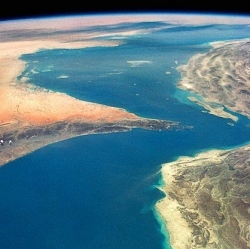
A pair of NASA space probes have detected an artificial bubble around Earth that forms when radio communications from the ground interact with high-energy radiation particles in space, the agency announced this week. The bubble forms a protective barrier around Earth, shielding the planet from potentially dangerous space weather.
Earth already has its own protective bubble, a magnetosphere stretched by powerful solar winds. The artificial bubble that NASA found is an accident, an unintended result of the interplay between human technology and nature. When humans want to communicate with submarines near the surface of the ocean, they use a type of radio communication known as very low frequency waves, or VLF, transmitted from stations on the ground.
Some of the waves can stretch all the way out into Earth’s atmosphere and beyond, where they affect the movement of the radiation particles bouncing around in the region. Sometimes, the interaction between VLF and these particles creates a barrier that can be seen by spacecraft orbiting the planet.
The bubble discovery comes from a robotic mission launched in 2012 to study the Van Allen radiation belts, two donut-shaped rings of charged particles that surround the Earth, held in place by the planet’s magnetic field. The results are described in a recent study in the journal Space Science Reviews.
Scientists say the edge of the outer edge of artificial bubble lines up almost exactly with the inner edge of the Van Allen belts, which suggests VLF waves can push radiation particles away. According to satellite data, the inner edge of the belts is much further from Earth now than it was in the 1960s, when humans sent fewer VLF transmissions. Scientists suspect that VLF wasn’t around, the radiation belts would hover closer to Earth.
The researchers believe the bubble could help protect Earth from solar flares, which release huge amounts of energy, or coronal mass ejections that discharge hot material called plasma. Both events send can radiation particles into Earth’s atmosphere, which could disrupt radio waves and overload electrical power grids.
The bubble also extends the reach of human influence on this tiny dot in the universe. Technology has, in a very short time, left a mark on the landscape of the Earth in countless ways, diverting whole rivers, razing forests for farmland, and pumping enough gases into the atmosphere to alter the global climate.
In the early 1960s, the U.S. military tried to build an artificial bubble of its own, and launched billions of whisker-thin copper wires into orbit. Scientists hoped the material would coalesce into a ring around the Earth that would protect the nation’s communications systems, crucial in the fight against the Soviets, from solar storms. It didn’t work, though. The key, it appears, is a little help from the universe itself.
